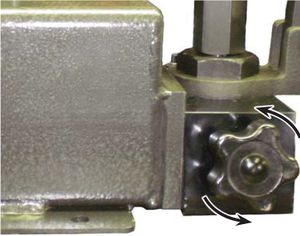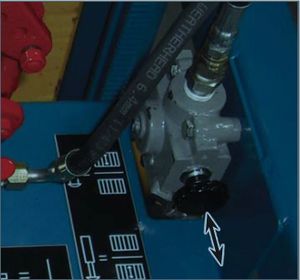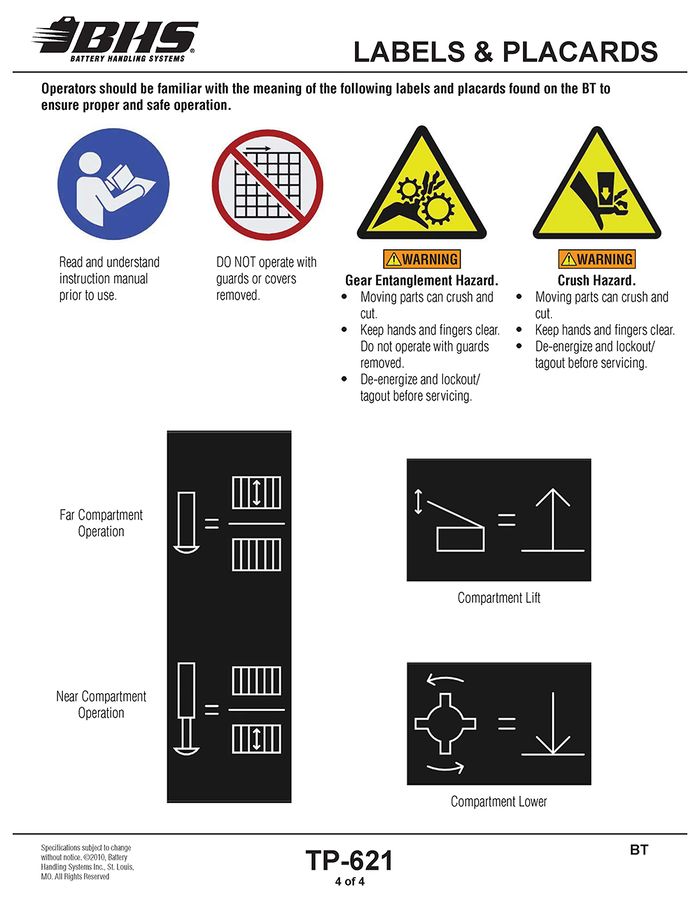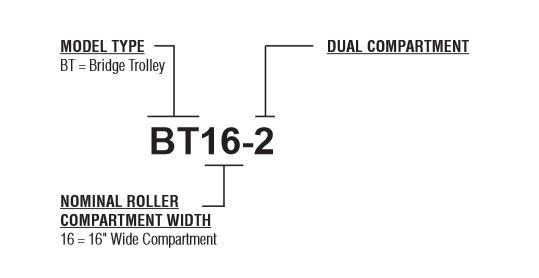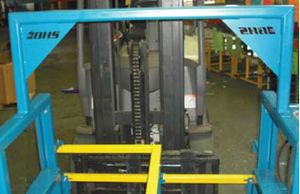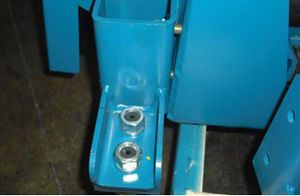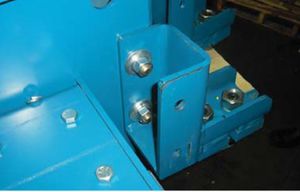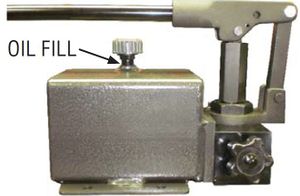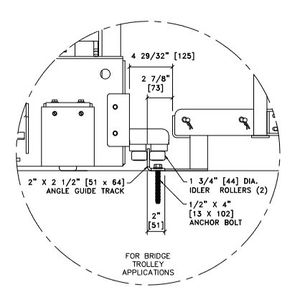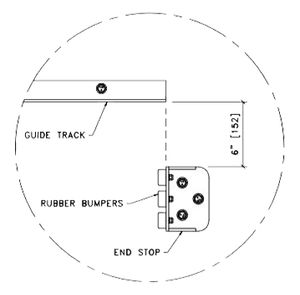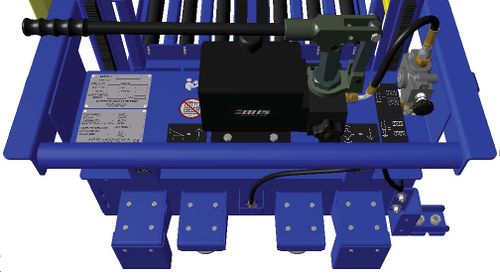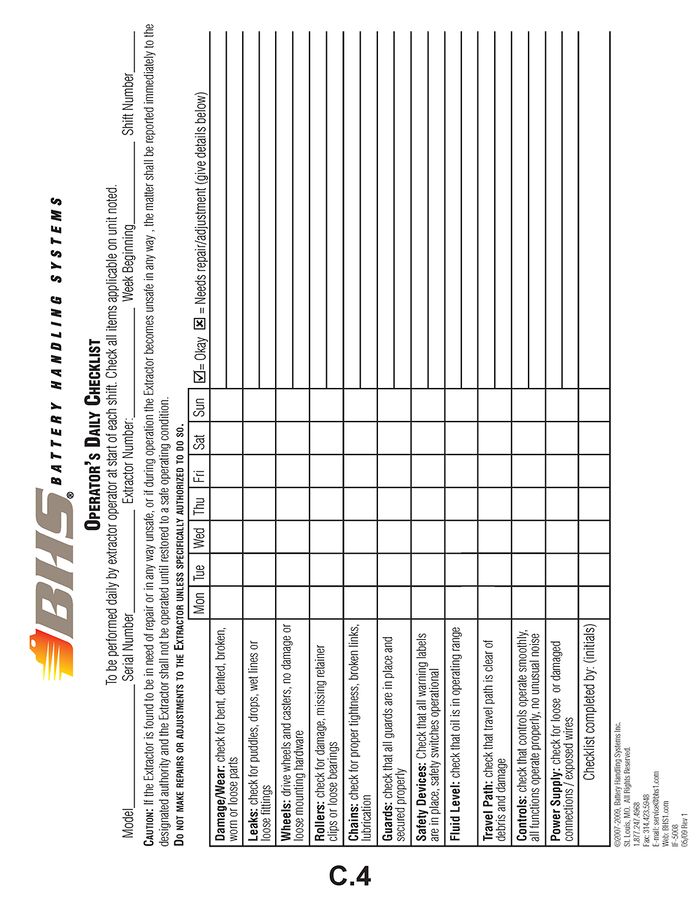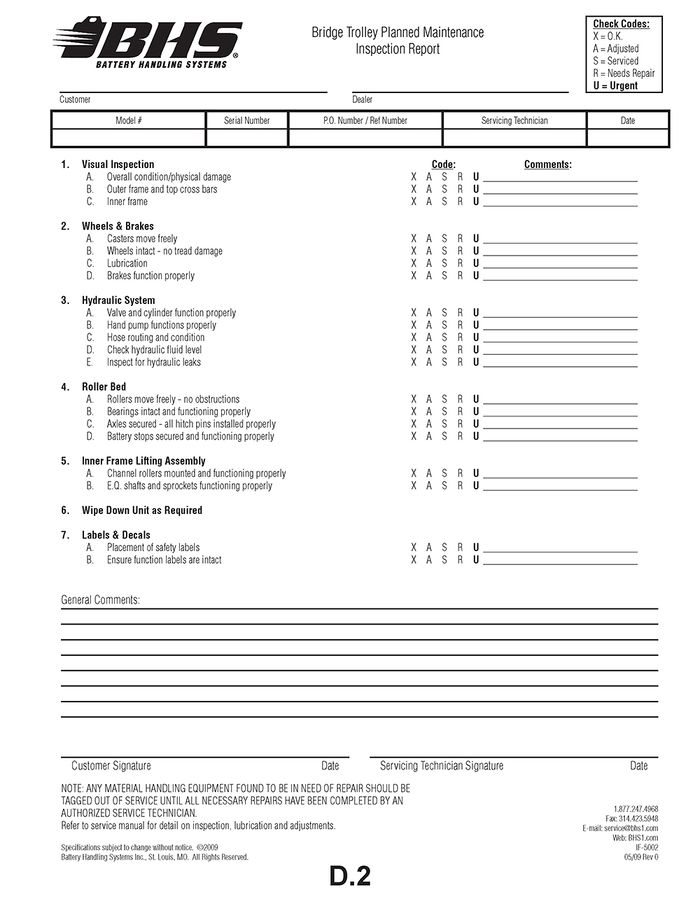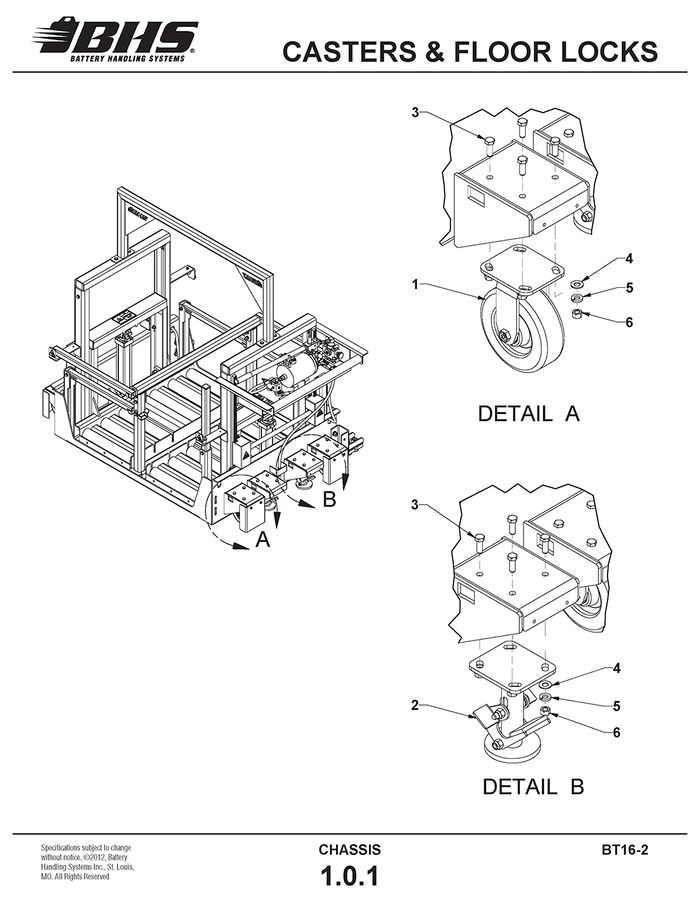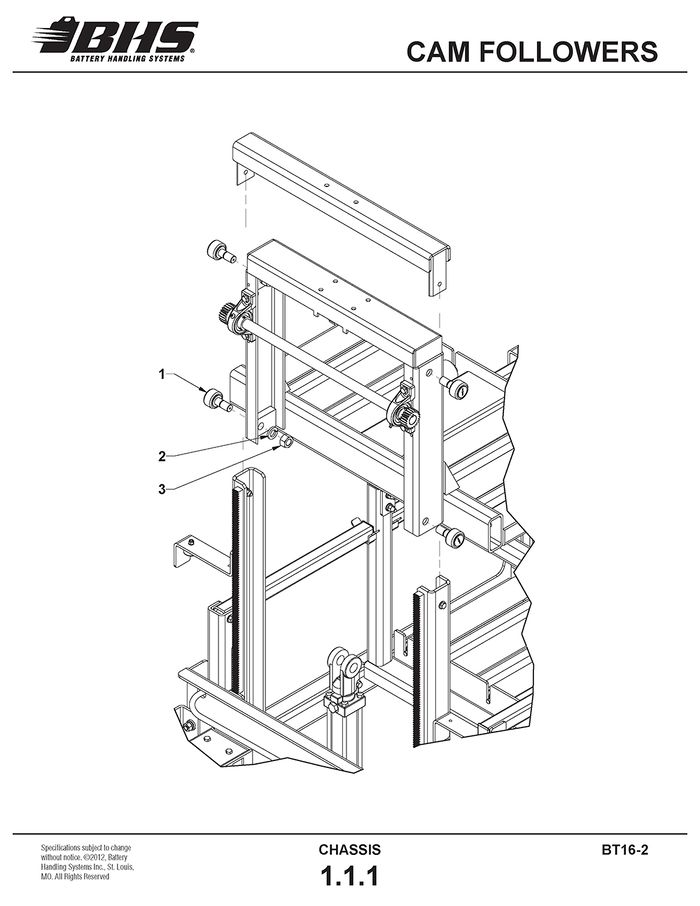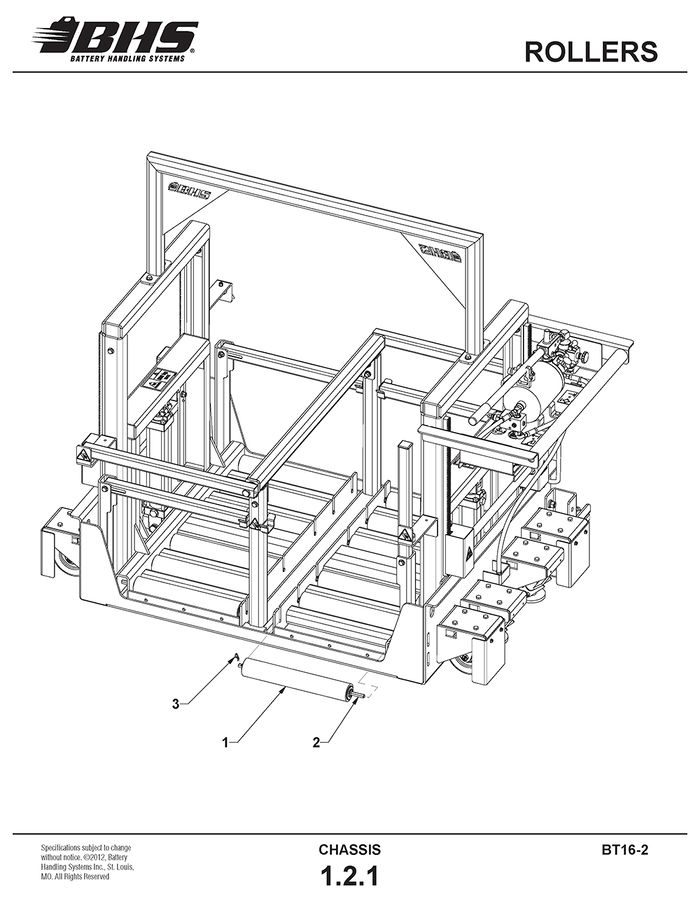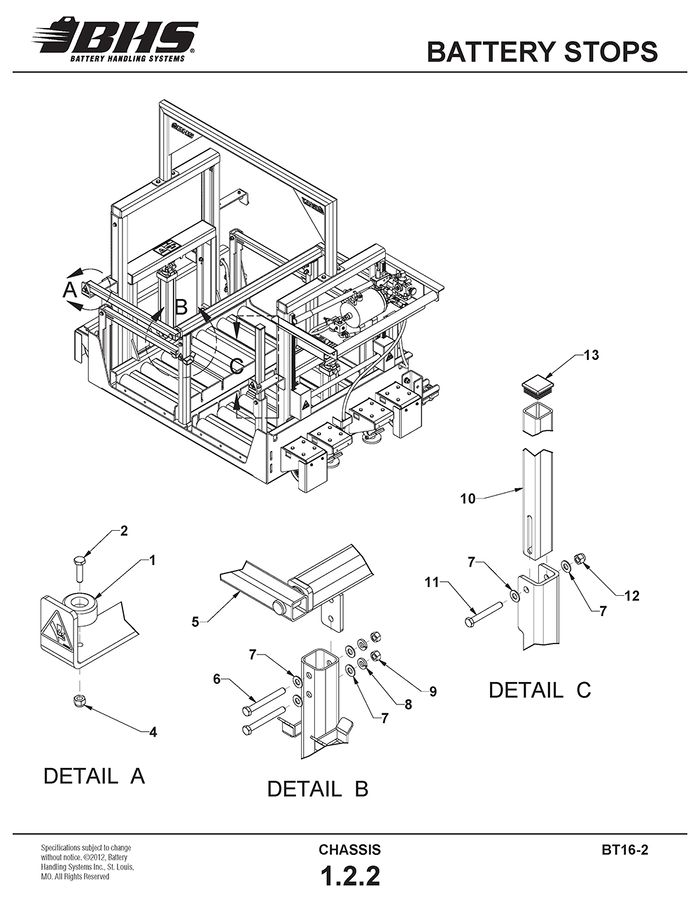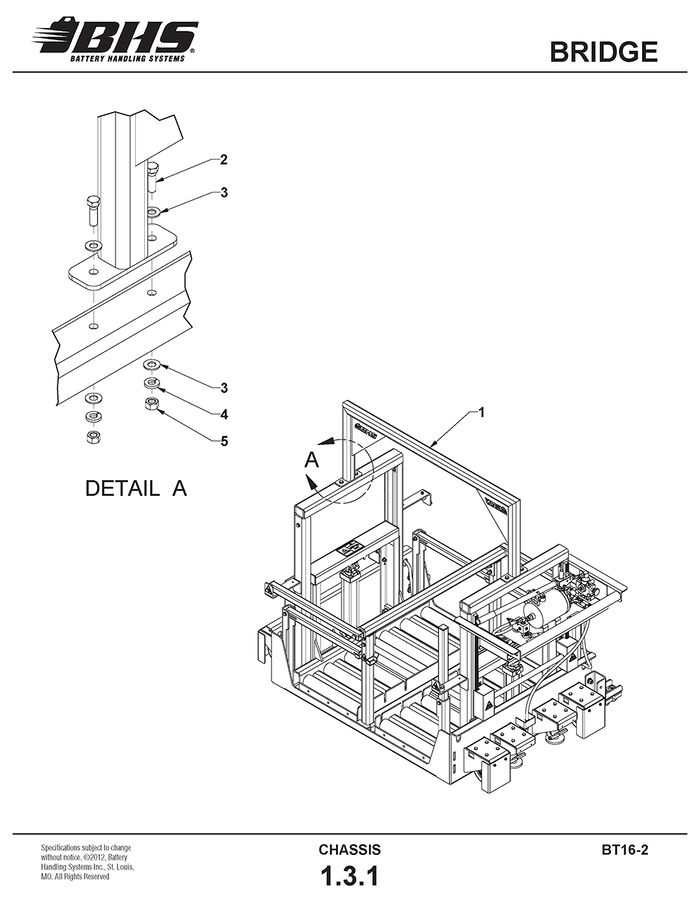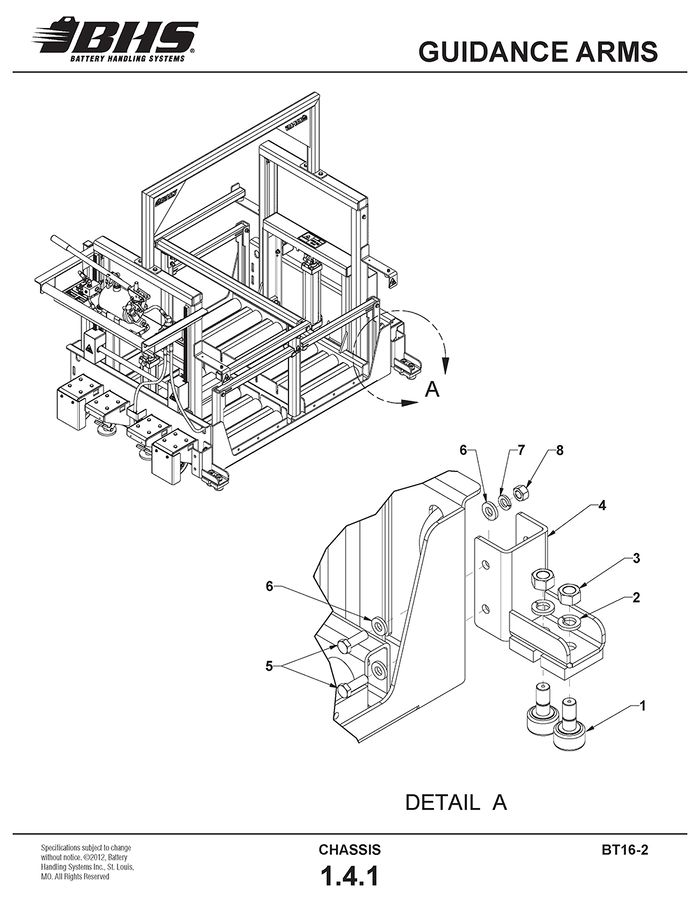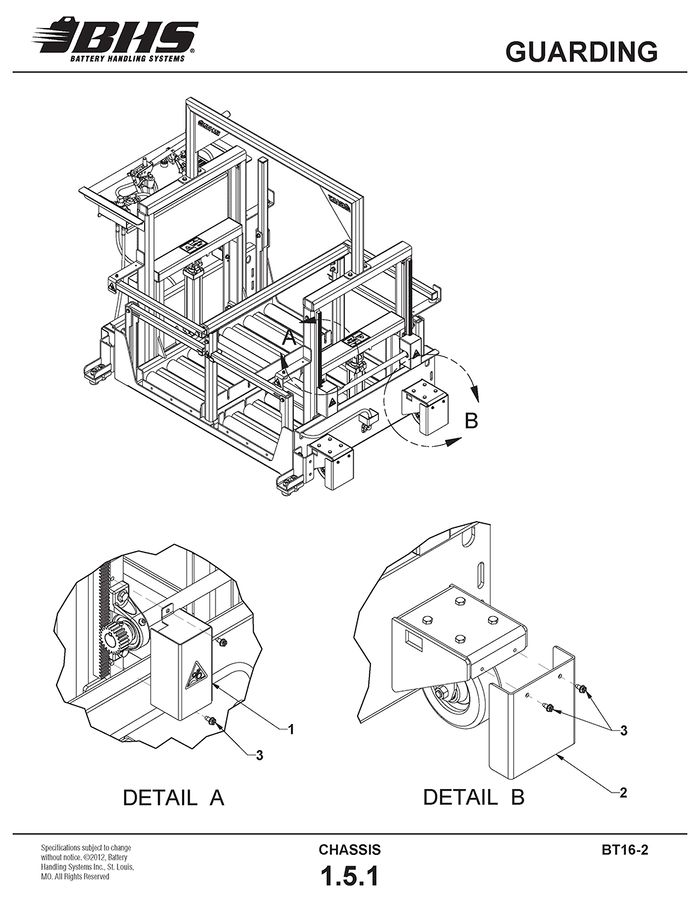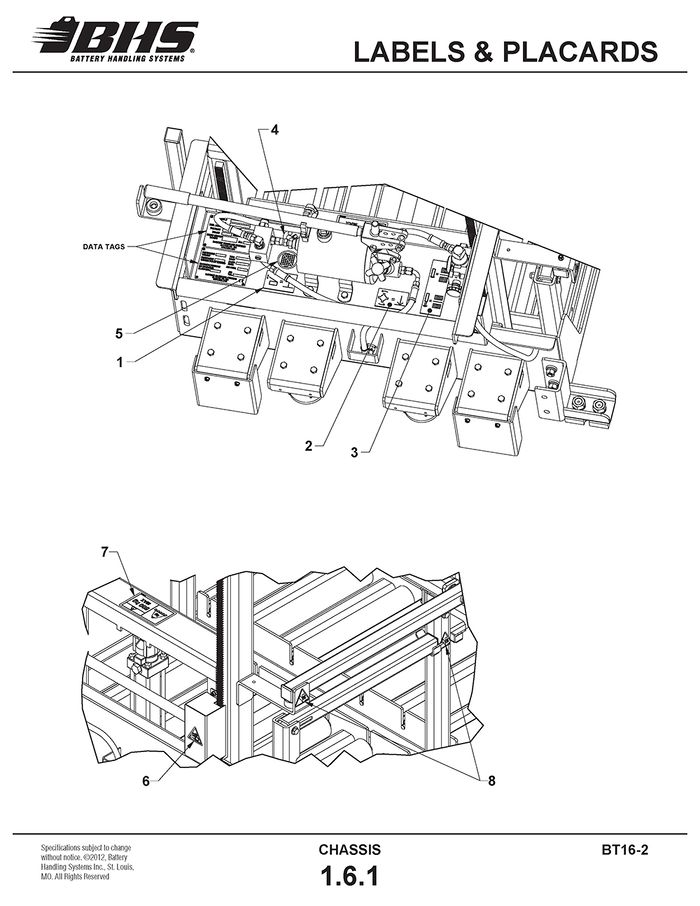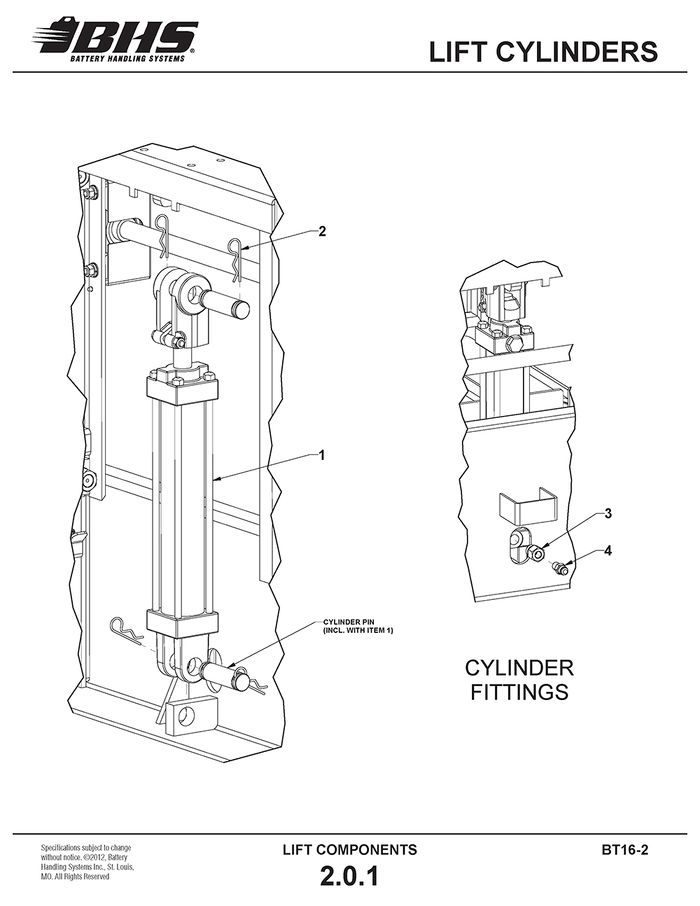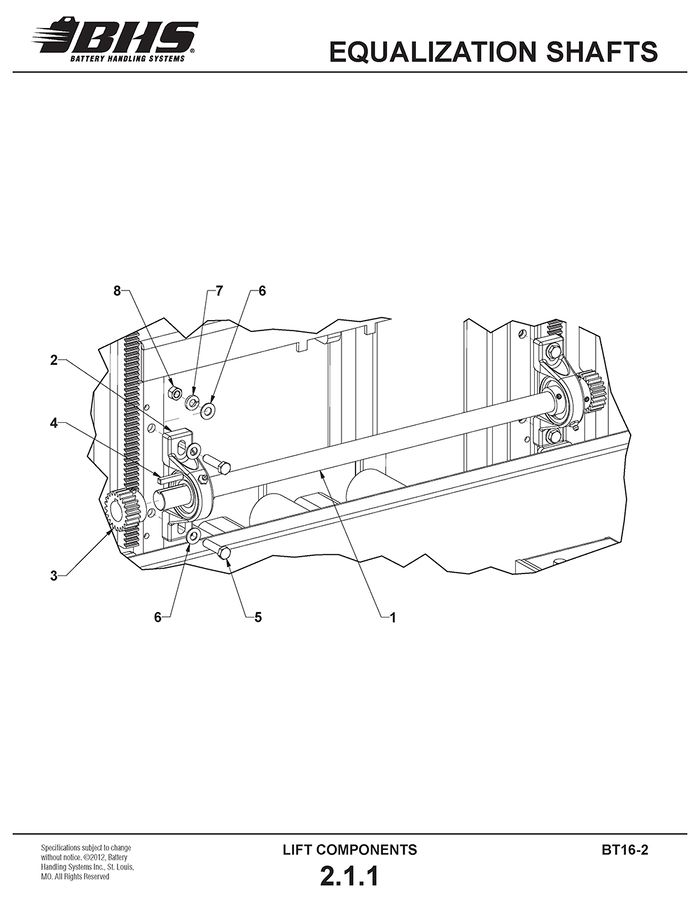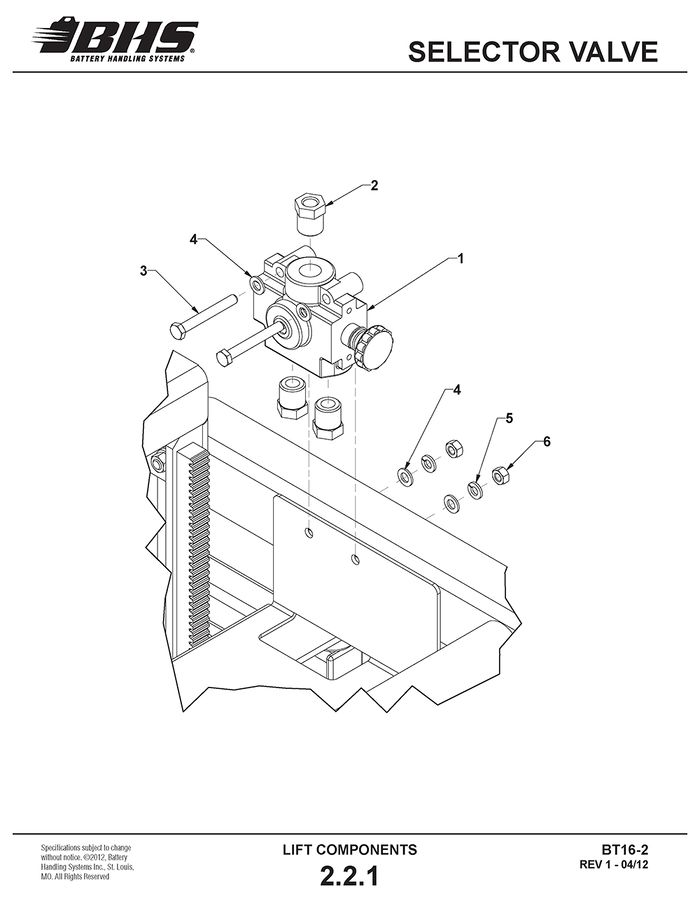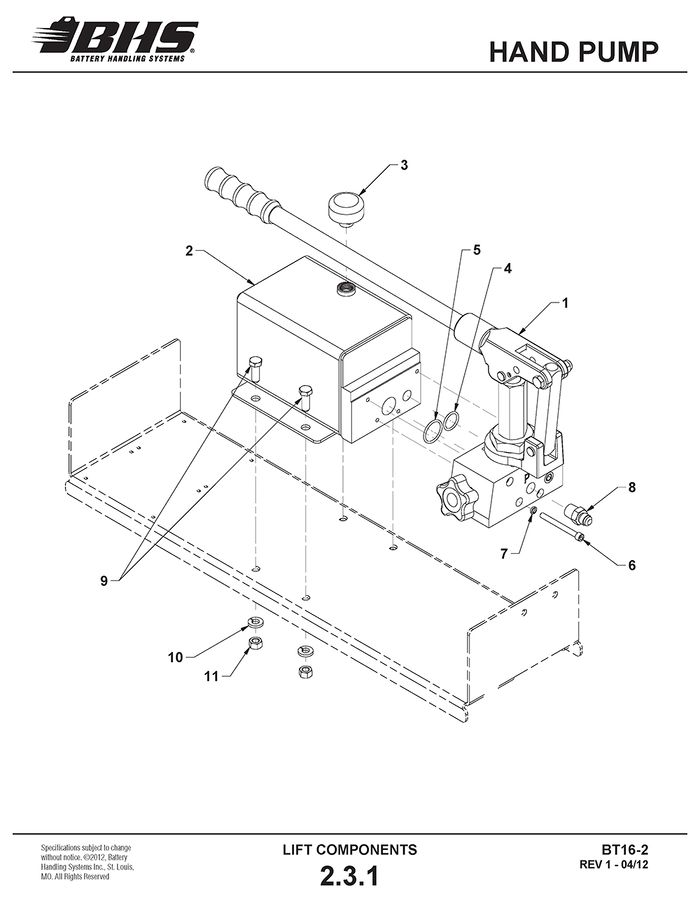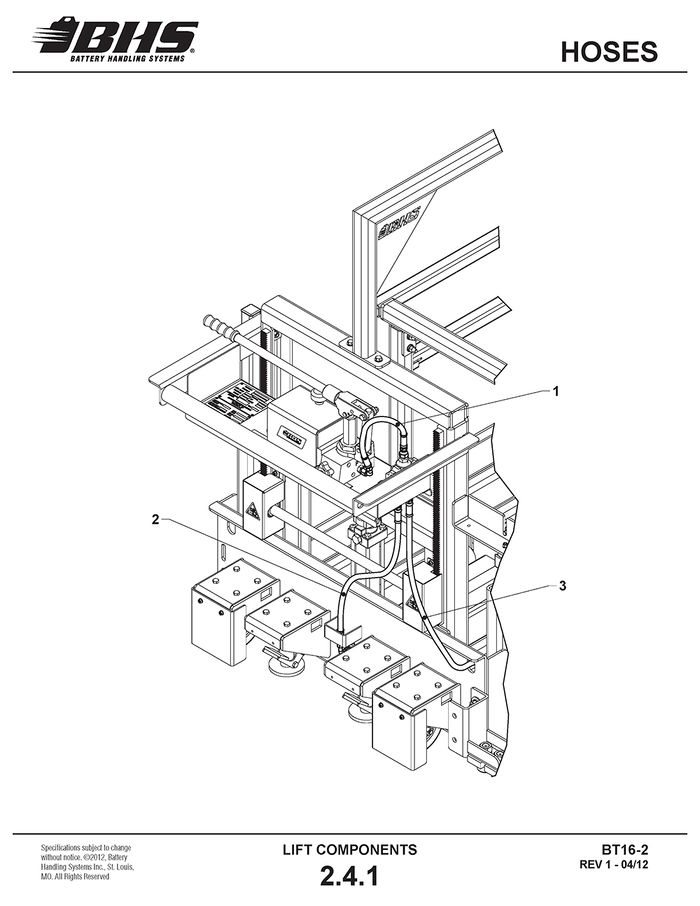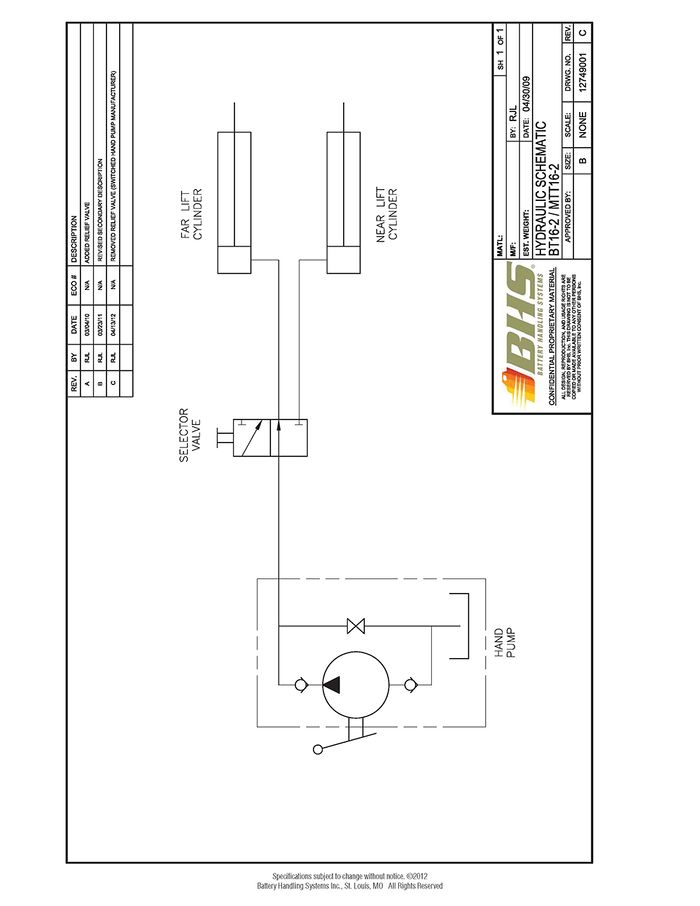IOP-128 BT16-2
Looking for a specific replacement part? Ctrl-F (or Command-F for Mac users) brings up your browsers search panel and can search any text on the entire web page. Find parts by searching a part # or part description.
Register your equipment with BHS Optima, BHS's free app.
California Residents: WARNING: This product contains chemicals known to the State of California to cause cancer and/or reproductive harm, and birth defects or other reproductive harm. Learn more here.
Bridge Trolley (BT16-2) Parts & Service Manual
TP-621 - SAFETY AND DE-ENERGIZATION PROCEDURES
GENERAL SAFETY
- Read and understand all instructions and warnings before using or servicing this equipment.
- Keep these instructions for future reference.
- Bridge Trolley (BT) units shall only be used indoors in an industrial setting on a hard, nonslip, and level floor without defects including but not limited to holes, gouges, cracks, drains or obstacles comprised of concrete or other suitable industrial material.
- Forces required to operate the BT vary with weight of the load, floor conditions and carriage conditions.
- BT units are not designed to be shipped or transported after initial delivery.
- A licensed structural engineer should be consulted prior to installing a BT on any building level other than the ground floor.
- Perform system and safety check before operating.
- Failure to follow these instructions and warnings may result in property damage, personal injury or death.
WORK AREA
- Keep work area clean and well lit. Cluttered work areas and poor lighting can lead to accidents.
- Clean up/contain any fluid spills immediately to prevent slips or falls.
- Be aware of potential hazards when performing any service or maintenance to the unit.
SERVICE & MAINTENANCE
Service personnel shall wear Personal Protective Equipment (PPE) appropriate for the task being performed.
LOCKOUT/TAGOUT
Lockout/tagout the BWC per your corporate policy, if damaged or not functioning properly. Lockout/tagout and de-energize all systems prior to performing any maintenance or service to unit.
LEAD-ACID BATTERIES-EXPLOSION HAZARD
Do not allow open flames or sparks of any kind near a battery. Highly explosive gas is generated when charging a battery that can remain in battery cells for extended periods of time after charging is complete.
- Always wear appropriate PPE including rubber apron, gloves, boots and full face shield when performing service or maintenance to any lead-acid batteries.
- Do not place metal or other conductive objects on top of battery. Arcing may occur causing damage to the battery and/or serious personal injury or death.
- Use only chargers matching the voltage and amperage of the battery being charged. Overcharging a battery can cause damage to the battery, charger and/or serious personal injury or death.
- Turn off charger before disconnecting battery from charger. Arcing between battery and charger connectors can cause damage to the connectors and/or serious personal injury or death.
HYDRAULIC HAZARDS
AVOID HIGH PRESSURE FLUIDS-Escaping fluid under pressure can penetrate the skin causing serious injury. Relieve pressure before disconnecting hydraulic lines. Tighten all connections before applying pressure. Keep hands and body away from pin holes which eject fluids under high pressure. Use a piece of cardboard or paper to search for leaks. DO NOT use your hand.
Any fluid injected into the skin under high pressure should be considered a serious medical emergency despite an initial normal appearance of the skin. There will be a delayed onset of pain, and serious tissue damage may occur. Medical attention should be sought immediately.
OPERATIONAL SAFETY
OPERATIONAL SAFETY
- Only personnel trained in the proper and safe operation of BT units may operate or service the BT.
- Operators shall wear appropriate PPE suitable for working with industrial lead-acid batteries while operating the BT (see prior page).
- All data plates, warning labels, placards, etc. shall be in place and legible at all times. Contact BHS for replacement data plates, warning labels, placards or instructions.
- All users and service personnel shall be familiar with the meaning and risks associated with all data plates, warning labels, etc.
- All operators and service personnel shall be aware of potential crush and shear points while operating or servicing the BT, including the casters and brakes.
- BT should be operated in an area with ambient light levels of at least 50 lux.
- Keep hands and arms out of the battery compartments while operating the BT.
- Engage the battery stop(s) prior to transporting the battery.
- Remove BT from service if damaged, defective, or operating improperly (or becomes such while operating) until repairs can be made to correct any problem(s).
DO’s AND DON’T’s
- DO NOT exceed the maximum capacity of the BT.
- DO NOT modify or fit the BT with attachments without prior, written approval from BHS.
- DO NOT perform any maintenance or service to the BT with a battery loaded in the BT.
- DO NOT allow anyone to ride in or on the BT.
- DO NOT push the BT into the end stops.
- DO NOT operate the BT if off the designated travel path or guidance track.
- DO NOT use the BT in a manner for which it is not intended. Some examples of prohibited use are but not limited to:
- As a scooter or to transport people
- As a vehicle jack
- To lift loads greater than its rated load capacity
- Where unintentional movement may exist
- Having direct contact with foodstuffs
DE-ENERGIZATION
- Turn the pump release handle counterclockwise to lower the currently selected compartment and relieve any stored hydraulic pressure. See Figure 1
- Using the compartment selector valve, select the other compartment and repeat step 1. See Figure 2.
- Escaping hydraulic fluid under high pressure (see HYDRAULIC HAZARDS in the GENERAL SAFETY section).
- Unexpected movement of hydraulic components.
FIGURE 1
FIGURE 2
Failure to lower the battery compartments when performing service to the BT could result in injury from the compartments lowering unexpectedly
Failure to release any stored hydraulic pressure could result in injury from:
LABELS & PLACARDS
GENERAL INFORMATION
The Bridge Trolley (BT) is used to remove large batteries from electric industrial trucks.
The bridge trolley is maneuvered manually along a designated travel path on casters by a person at the rear of the unit by pushing/ pulling on the handle of the unit. It is directed along this path by a guide track mounted permanently to the floor. The battery compartments are raised and lowered independently using a manual hand pump located at the rear of the unit with a manual valve to switch operation between compartments. The batteries are removed from the truck by the operator physically grasping the battery and pushing or pulling the batteries on and off of the unit.
SPECIFICATIONS
Product Specifications - Imperial / Metric
Service Weight (unloaded) | 892 lbs / 405 kg |
Max. Load Capacity (per compartment) | 1100 lbs / 500 kg |
Pump Type | Manual Hydraulic, Hand Operated |
Pressure Rating | 1300 psi / 89 bar |
Oil Volume Per Stroke | 1.25 in3 / 20.5 cc |
Lift Speed | 1 Stroke = .375" / 9.5 mm |
Oil Type / Capacity | Mineral Based ISO 32 wt / .5 gal / 1.9 L |
# of Compartments | 2 Independently Controlled |
Compartment Size (W x L) | 15.813" x 33.875" / 401 mm x 860 mm |
Rollers Per Compartment | 6 |
Roller Diameter | 2.4" / 61 mm |
Roller Construction | Steel Tube Core with .25"/ 6.4 mm Polyurethane Sleeve |
Roller Shaft Size | .438" / 11.1 mm Hex |
Overall Width (not including guide arms) | 43.625" / 1108 mm |
Overall Height | 58" / 1473 mm |
Overall Length | 70.125" / 1781 mm |
Ground Clearance | .5" / 13 mm |
Roller Height Service Range | 3.875" - 13.875" / 98 mm - 352 mm |
Cylinder Type | Single Acting - Power Up / Gravity Down |
Cylinder Size | 2" Bore x 10" Stroke x 1" Rod Dia. 51 mm x 254 mm x 25 mm |
Cylinder Mounting | Double Clevis |
# of Brakes / Type | 2 / Cam Type Pedestals with Rubber Floor Pad |
Caster Size | 6" x 2" / 152 mm x 51 mm |
Caster Material | Phenolic Resin (Polyolefin) |
Caster Capacity (each) | 1200 lbs / 544 kg |
INSTALLATION
The following describes the basic installation procedures for the bridge trolley system.
Once the trolley has been removed from the shipping pallet, some minor assembly may be required.
Note: If the unit has been shipped without the bridge attached, DO NOT remove the bands going across the unit in place of the bridge until the bridge has been fully installed.
Bridge Trolley
- Engage the floor locks to prevent the trolley from moving.
- Position the bridge as shown in Figure 1. Note: If unit is shipped with the bridge installed, steps 2 & 3 will be skipped.
- Install and tighten the bridge hardware. Carefully cut and remove banding.
- Determine which side of the trolley is to be the track side.
- Install the guidance arms on the track side of the unit as shown in Figures 2 & 3.
- Adjust the height of the guidance arms as necessary to ensure full engagement of the guide rollers with the entire length of track without the guidance arm bracket contacting the top edge of the track.
- Check the hydraulic pump oil level. Oil level should be 1" from the top of the reservoir. If low, fill with Chevron hydraulic oil AW ISO 32 or equivalent ISO 32 grade hydraulic oil with anti-wear additives and foam suppressant. Pump capacity is approximately 0.5 Gal (1.9 L). Note: Oil level must be checked with both roller compartments FULLY lowered. See Figure 4.
FIGURE 1
FIGURE 2
FIGURE 3
FIGURE 4
Guide Track
Note: Reference system layout drawing if available. If no drawing is available, proceed as follows.
- Single Change Out - Determine which end of the system will be the truck change out end. The opposite end will be the starting point for installing the track. 48" (1219 mm) over-travel will be required at this end to allow complete access of both battery compartments to the endmost battery stand compartment. Dual Change Out - If trucks are to be serviced at both ends of the system, it is recommended that the overall truck length, battery removal side and position all be verified and then proper over-travel past the truck compartment be added to obtain track location (typically 48"/1219 mm).
- Measure and mark 2 7/8" (73 mm) from the front angle of the battery stands at each end of the system. See Figure 5.
- Using a chalk line, "snap" a line connecting the marks made in the previous step. This line will serve as an alignment guide for the location of the guide track. Note: Be sure to start the chalk line past the end of the stand allowing for over-travel of the trolley per step 1 and that the line is at least as long as the total length of track being installed.
- Position the first piece of guide track ensuring it is aligned with the chalk line and the proper over-travel is accounted for. Place all track sections end to end to verify correct track length and location prior to anchoring.
- Anchor the track section at each end and once in the center using the supplied 1/2" x 4" wedge bolts anchors. Anchor the entire section at each remaining hole.
- Position the next section, clamping it to the previous section installed. Anchor the hole closest to the joint. Verify alignment with the chalk line and continue anchoring per step 5.
- Continue installing each remaining sections per steps 5 & 6 ensuring the track is aligned with the chalk line.
- Position the end stops flush with the ends of the track and 6" (152 mm) from the face of the track. The rubber bumpers should face toward the trolley. See Figure 6.
- Anchor each end stop with (3) 1/2" x 4" wedge bolt anchors.
FIGURE 5
FIGURE 6
OPERATION
OPERATING CONTROLS
- SERIAL NUMBER / DATA TAGS Lists Model and Serial Number as well as operational data of unit.
- HAND PUMP Raises selected battery compartment.
- RELEASE HANDLE Lowers selected battery compartment.
- COMPARTMENT SELECTOR VALVE Changes control from near to far compartment.
- FLOOR LOCKS Used to prevent unintended movement of unit.
OPERATIONAL TEST
After the initial installation has been completed or any service to the unit has been performed, an operational test should be conducted to ensure proper functions of the unit prior to returning the bridge trolley back into service.
- Ensure release handle is completely closed.
- Pump handle and verify selected compartment raises.
- Slowly turn release handle to verify selected compartment lowers.
- Switch operation to opposite compartment and repeat steps 2 & 3.
- Engage fl oor locks and ensure the unit does not move when pushed or pulled with moderate force.
OPERATING INSTRUCTIONS
The following instructions will guide you through the basic steps necessary to operate and change batteries with a BT16-2.
Operators must be equipped with all necessary personal safety equipment and be properly trained in the handling of lead-acid lift truck batteries.
1. If not already in place, position the industrial truck (pallet or lift truck) which requires a battery change in the appropriate staging area.
2. Disconnect the battery leads and remove any battery restraints.
3. Move the bridge trolley into position such that an empty roller compartment of the unit is aligned with the battery compartment of the industrial truck and engage both floor locks.
4. Verify the Z-bar stop is open and the battery stop of the desired roller compartment is in the vertical position. Note: All other battery stops not in use must be left in their down or closed position.
5. To operate the near compartment, pull the selector valve handle all the way out. To operate the far compartment, push the selector valve handle all the way in.
6. Adjust the vertical height of the desired roller compartment of the bridge trolley to the battery compartment of the industrial truck. To lift the compartment, pump the handle up and down. To lower the compartment, turn the release handle of the hand pump counterclockwise to begin lowering and turn the handle clockwise to stop.
7. Carefully pull the lift truck battery into the bridge trolley battery compartment and return the battery stop to the closed position.
8. Release the floor locks and move the bridge trolley to align the empty roller compartment with a battery rack compartment containing a charged battery. Reengage both floor locks and raise the battery stop of the compartment to accept the charged battery. Note: The Z-bar stop should still be in the open position from removing the lift truck battery.
9. Adjust the vertical height of the desired roller compartment of the bridge trolley to the battery compartment of the battery rack.
10. Carefully pull the lift truck battery into the bridge trolley battery compartment and return the battery stop to the closed position.
11. Release the floor locks and move the bridge trolley to align the charged battery with the battery compartment of the lift truck. Reengage both floor locks and adjust the bridge trolley compartment height as necessary.
12. Raise the battery stop of the compartment to transfer the charged battery to the lift truck and rotate the Z-bar to the open position.
13. Push the battery into the lift truck compartment and reconnect the battery leads and restraints disconnected in step 2.
14. Return the discharged battery to the battery rack using the methods described above. The battery may now be connected to the charger as required.
15. Move the bridge trolley to the appropriate staging area when not in use and engage the floor locks to prevent unintentional movement.
As with all material handling equipment, the transfer carriage should be inspected prior to each use for any visual damage. It should also undergo a routine inspection by trained maintenance personnel to verify and maintain the load capacity of the unit.
OPERATOR’S DAILY CHECKLIST
SERVICE & MAINTENANCE
The following items are recommended by the factory to have on hand for BT16-2 models to minimize any downtime due to minor breakdown that may occur under normal operating conditions.
BHS PART NUMBER | DESCRIPTION | QTY | REFERENCE SECTION | NOTES |
C0015 | CASTER-6" X 2" | 4 | 1.0.1 | |
C0010-1 | FLOOR LOCK | 2 | 1.0.1 |
Use only BHS approved replacement parts.
BHS recommends that a full maintenance inspection report similar to the one provided be done at least once a month.
Any parts found to be excessively worn or damaged should promptly be replaced unless said parts pose a safety risk to the operator and/or extractor, in which case the unit should be removed from service until the problem(s) are remedied (See Operator’s Daily Checklist.)
DISPOSAL OF WASTE MATERIAL
Dispose of all fluids and waste according to local regulations.
Bridge Trolley Planned Maintenance Inspection Report
PARTS SECTIONS
CHASSIS
CASTERS & FLOOR LOCKS
ITEM | BHS PART NUMBER | DESCRIPTION | REF. KIT NO. | NOTES | NO. REQ |
1 | C0015 | CASTER-6" X 2" | 4 | ||
2 | C0010-1 | FLOOR LOCK | 2 | ||
3 | HW0403 | BOLT-HHCS-3/8-16 X 1 1/4" | 24 | ||
4 | HW0108 | WASHER-FLAT-3/8"-SAE | 24 | ||
5 | HW0107 | WASHER-LOCK-3/8" | 24 | ||
6 | HW0005 | NUT-HEX-3/8-16 | 24 |
CAM FOLLOWERS
ITEM | BHS PART NUMBER | DESCRIPTION | REF. KIT NO. | NOTES | NO. REQ |
1 | PT0501 | CAM FOLLOWER | 8 | ||
2 | HW0115 | WASHER-LOCK-3/4" | 8 | ||
3 | HW0011 | NUT-HEX-3/4-16 | 8 |
ROLLERS
ITEM | BHS PART NUMBER | DESCRIPTION | REF. KIT NO. | NOTES | NO. REQ |
1 | 00182002 | ROLLER ASSEMBLY | 12 | ||
2 | 12787001 | SHAFT-HEX-.438" X 17.875" | 12 | ||
3 | HW1014-1 | PIN-HITCH | 12 |
BATTERY STOPS
ITEM | BHS PART NUMBER | DESCRIPTION | REF. KIT NO. | NOTES | NO. REQ |
1 | HW1037 | BUMPER-RUBBER-RECESSED | 80092001 | 4 | |
2 | HW0303 | BOLT-HHCS-1/4-20 X 1" | 80092001 | 4 | |
3 | HW0104 | WASHER-FLAT-1/4"-SAE | 80092001 | 4 | |
4 | HW0003 | NUT-NILN-1/4-20 | 80092001 | 4 | |
5 | 12715009 | Z-BAR STOP ASSEMBLY | 1 | ||
6 | HW0408 | BOLT-HHCS-3/8-16 X 3 1/4" | 4 | ||
7 | HW0108 | WASHER-FLAT-3/8"-SAE | 16 | ||
8 | HW0107 | WASHER-LOCK-3/8" | 4 | ||
9 | HW0005 | NUT-HEX-3/8-16 | 4 | ||
10 | 12717027 | STOP-BATTERY | 4 | ||
11 | HW0407 | BOLT-HHCS-3/8-16 X 2 3/4" | 4 | ||
12 | HW0006 | NUT-NILN-3/8-16 | 4 | ||
13 | PL0402 | CAP-TUBE END | 6 |
BRIDGE
ITEM | BHS PART NUMBER | DESCRIPTION | REF. KIT NO. | NOTES | NO. REQ |
1 | 12715005 | BRIDGE | 1 | ||
2 | HW0403 | BOLT-HHCS-3/8-16 X 1 1/4" | 4 | ||
3 | HW0108 | WASHER-FLAT-3/8"-SAE | 8 | ||
4 | HW0107 | WASHER-LOCK-3/8" | 4 | ||
5 | HW0005 | NUT-HEX-3/8-16 | 4 |
GUIDANCE ARMS
ITEM | BHS PART NUMBER | DESCRIPTION | REF. KIT NO. | NOTES | NO. REQ |
1 | PT0501 | CAM ROLLER-1 3/4" | 4 | ||
2 | HW0115 | WASHER-LOCK-3/4" | 4 | ||
3 | HW0011 | NUT-HEX-3/4-16 | 4 | ||
4 | 12715006 | GUIDE ARM | 2 | ||
5 | HW0503 | BOLT-HHCS-1/2-13 X 1 1/2" | 4 | ||
6 | HW0112 | WASHER-FLAT-1/2"-SAE | 8 | ||
7 | HW0110 | WASHER-LOCK-1/2" | 4 | ||
8 | HW0007 | NUT-HEX-1/2-13 | 4 |
GUARDING
ITEM | BHS PART NUMBER | DESCRIPTION | REF. KIT NO. | NOTES | NO. REQ |
1 | 05115018 | GUARD-EQUALIZATION SHAFT | 4 | ||
2 | 12717024-2 | GUARD-CASTER | 4 | ||
3 | HW0301 | BOLT-SELF-TAP "F"-1/4-20 X 1/2" | 16 |
LABELS & PLACARDS
ITEM | BHS PART NUMBER | DESCRIPTION | REF. KIT NO. | NOTES | NO. REQ |
1 | 12796001 | PLACARD-RAISE | 1 | ||
2 | 12796002 | PLACARD-LOWER | 1 | ||
3 | 12796003 | PLACARD-COMPARTMENT-NEAR/FAR | 1 | ||
4 | 00196612 | LABEL-"READ INSTRUCTION MANUAL PRIOR TO USE" | 1 | ||
5 | 00196615 | LABEL-"DO NOT OPERATE WITH GUARDS REMOVED" | 1 | ||
6 | 00196217 | LABEL-WARNING-"GEAR ENTANGLEMENT HAZARD" | 4 | ||
7 | 00196725 | LABEL-CAPACITY- "1100 LBS" | 2 | ||
8 | 00196222 | LABEL-WARNING-"CRUSH HAZARD" | 6 |
LIFT COMPONENTS
LIFT CYLINDERS
ITEM | BHS PART NUMBER | DESCRIPTION | REF. KIT NO. | NOTES | NO. REQ |
1 | HC0440 | CYLINDER-LIFT | 2 | ||
2 | HW1058 | PIN-HITCH | 8 | ||
3 | H1000 | ADAPTER-#8 SAEM X #4 FNPT | 2 | ||
4 | H1504 | ADAPTER-#6 JICM X #4 NPT | 2 |
EQUALIZATION SHAFTS
ITEM | BHS PART NUMBER | DESCRIPTION | REF. KIT NO. | NOTES | NO. REQ |
1 | 12717001 | SHAFT-LIFT EQUALIZATION | 2 | ||
2 | PT0401 | BEARING-PILLOW BLOCK-1" | 4 | ||
3 | PT0606 | SPUR GEAR-1" | 22 TOOTH | 4 | |
4 | 00197019 | KEY-1/4" X 1 3/8" | 4 | ||
5 | HW0404 | BOLT-HHCS-3/8-16 X 1 1/2" | 8 | ||
6 | HW0108 | WASHER-FLAT-3/8"-SAE | 16 | ||
7 | HW0107 | WASHER-LOCK-3/8" | 8 | ||
8 | HW0005 | NUT-HEX-3/8-16 | 8 |
SELECTOR VALVE
ITEM | BHS PART NUMBER | DESCRIPTION | REF. KIT NO. | NOTES | NO. REQ |
1 | HC0294 | VALVE-SELECTOR | 1 | ||
2 | H0201 | REDUCER-#8 NPT X #4 FNPT | 3 | ||
3 | HW0335 | BOLT-HHCS-5/16-18 X 2 1/2" | 2 | ||
4 | HW0106 | WASHER-FLAT-5/16"-SAE | 4 | ||
5 | HW0105 | WASHER-LOCK-5/16" | 2 | ||
6 | HW0004 | NUT-HEX-5/16-18 | 2 |
HAND PUMP
ITEM | BHS PART NUMBER | DESCRIPTION | REF. KIT NO. | NOTES | NO. REQ |
1 | HC0390 | HAND PUMP | 1 | ||
2 | 12745001 | RESERVOIR | 1 | ||
3 | HC0393 | BREATHER-TANK | 1 | ||
4 | HC0391 | O-RING 1 1/1 X 1 1/4 | 1 | ||
5 | HC0392 | O-RING 1 X 1 13/16 | 1 | ||
6 | HW0320 | BOLT-SHCS-1/4-20 X 2 1/2 | 4 | ||
7 | HW0151 | WASHER-LOCK-1/4"=HI-COLLAR | 4 | ||
8 | H1506 | ADAPTER-#6 JICM X #6 NPT | 1 | ||
9 | HW0402 | BOLT-HHCS-3/8-16 X 1" | 4 | ||
10 | HW0107 | WASHER-LOCK-3/8" | 4 | ||
11 | HW0005 | NUT-HEX-3/8-16 | 4 |
HOSES
ITEM | BHS PART NUMBER | DESCRIPTION | REF. KIT NO. | NOTES | NO. REQ |
1 | 00142001-88 | HOSE-HYDRAULIC-12" | 1 | ||
2 | 00142001-89 | HOSE-HYDRAULIC-36" | 1 | ||
3 | 00142001-90 | HOSE-HYDRAULIC-108" | 1 |
HYDRAULIC SCHEMATIC
STATEMENT OF WARRANTY
Statement of Warranty
Click here for details on BHS' Statement of Warranty.
